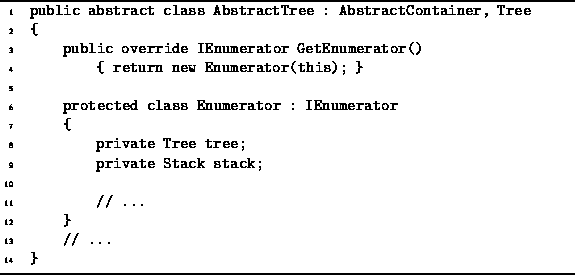|
Data Structures and Algorithms
with Object-Oriented Design Patterns in C# |
This section describes the implementation of an enumerator which can be used to step through the contents of any tree instance. For example, suppose we have declared a variable tree which refers to a BinaryTree. Then we can view the tree instance as a container and print its contents as follows:
Tree tree = new BinaryTree();
// ...
IEnumerator e = tree.GetEnumerator();
while (e.MoveNext())
{
Object obj = e.Current;
Console.WriteLine(obj);
}
Every concrete class that implements the Container interface
must provide a GetEnumerator method.
This method returns an object that implements
the IEnumerator interface defined in Section ![]() .
The enumerator can then be used to systematically visit the contents
of the associated container.
.
The enumerator can then be used to systematically visit the contents
of the associated container.
We have already seen that when we systematically visit the nodes of a tree,
we are doing a tree traversal.
Therefore, the implementation of the enumerator must also do a tree traversal.
However, there is a catch.
A recursive tree traversal method such as DepthFirstTraversal
keeps track of where it is implicitly
using the C# virtual machine stack.
However, when we implement an enumerator
we must keep track of the state of the traversal explicitly.
This section presents an enumerator implementation which does
a preorder traversal of the tree and keeps track of the current state
of the traversal using a stack from Chapter ![]() .
.
Program ![]() introduces the private nested class Enumerator
declared within the AbstractTree class.
The Enumerator class implements
the IEnumerator interface defined in Section
introduces the private nested class Enumerator
declared within the AbstractTree class.
The Enumerator class implements
the IEnumerator interface defined in Section ![]() .
The Enumerator contains two fields--tree and stack.
As shown in Program
.
The Enumerator contains two fields--tree and stack.
As shown in Program ![]() ,
the GetEnumerator method of the AbstractTree class
returns a new instance of the Enumerator class each time it is called.
,
the GetEnumerator method of the AbstractTree class
returns a new instance of the Enumerator class each time it is called.

Program: AbstractTree class GetEnumerator method and the Enumerator class.